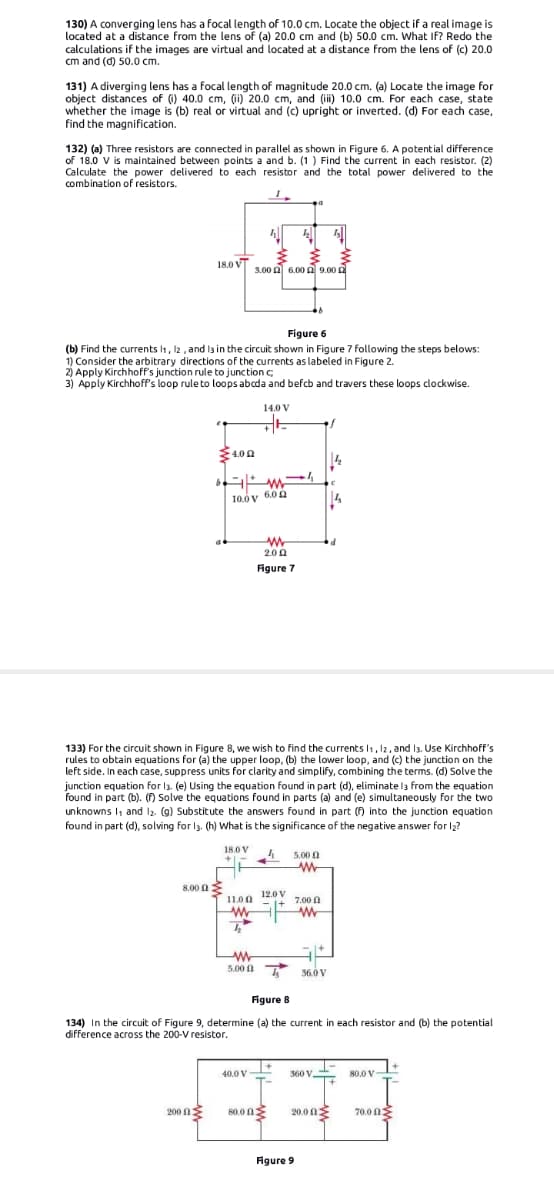130) A converging lens has a focal length of 10.0 cm. Locate the object if a real image is located at a distance from the lens of (a) 20.0 cm and (b) 50.0 cm. What If? Redo the calculations if the images are virtual and located at a distance from the lens of (c) 20.0 and (0) 50.0 cm.
130) A converging lens has a focal length of 10.0 cm. Locate the object if a real image is located at a distance from the lens of (a) 20.0 cm and (b) 50.0 cm. What If? Redo the calculations if the images are virtual and located at a distance from the lens of (c) 20.0 and (0) 50.0 cm.
Physics for Scientists and Engineers, Technology Update (No access codes included)
9th Edition
ISBN:9781305116399
Author:Raymond A. Serway, John W. Jewett
Publisher:Raymond A. Serway, John W. Jewett
Chapter36: Image Formation
Section: Chapter Questions
Problem 36.46P: A diverging lens has a focal length of magnitude 20.0 cm. (a) Locate the image for object distances...
Related questions
Question

Transcribed Image Text:130) A converging lens has a focal length of 10.0 cm. Locate the object if a real image is
located at a distance from the lens of (a) 20.0 cm and (b) 50.0 cm. What If? Redo the
calculations if the images are virtual and located at a distance from the lens of (c) 20.0
cm and (d) 50.0 cm.
131) A diverging lens has a focal length of magnitude 20.0 cm. (a) Locate the image for
object distances of (i) 40.0 cm, (ii) 20.0 cm, and (ii) 10.0 cm. For each case, state
whether the image is (b) real or virtual and (c) upright or inverted. (d) For each case,
find the magnification.
132) (a) Three resistors are connected in parallel as shown in Figure 6. A potential difference
of 18.0 V is maintained between points a and b. (1 ) Find the current in each resistor. (2)
Calculate the power delivered to each resistor and the total power delivered to the
combination of resistors.
18.0 VT
3.00 0 6.00 0 9.00 a
Figure 6
(b) Find the currents I, l2 , and la in the circuit shown in Figure 7 following the steps belows:
1) Consider the arbitrary directions of the currents as labeled in Figure 2.
2) Apply Kirchhoff's junction rule to junction c;
3) Apply Kirchhoff's loop rule to loops abcda and befcb and travers these loops clockwise.
14.0 V
1.02
10.0v 6.00
14
2.0 0
Figure 7
133) For the circuit shown in Figure 8, we wish to find the currents I1, 12, and 13. Use Kirchhoff's
rules to obtain equations for (a) the upper loop, (b) the lower loop, and (c) the junction on the
left side. In each case, suppress units for clarity and simplify, combining the terms. (d) Solve the
junction equation for l3. (e) Using the equation found in part (d), eliminate la from the equation
found in part (b). () Solve the equations found in parts (a) and (e) simultaneously for the two
unknowns I, and 12. (g) Substitute the answers found in part (A into the junction equation
found in part (d), solving for l3. (h) What is the significance of the negative answer for l2?
18.0 V
5.00 0
8.00 0
1100 12.0 V
11.00
7.00 1
5.00 0 560V
Figure 8
134) In the circuit of Figure 9, determine (a) the current in each resistor and (b) the potential
difference across the 200-V resistor.
40.0 V
360 V.
80.0 V
200 nE
s0.0 n
20.0n
70.0 n
Figure 9
Expert Solution
This question has been solved!
Explore an expertly crafted, step-by-step solution for a thorough understanding of key concepts.
Step by step
Solved in 3 steps with 2 images

Recommended textbooks for you

Physics for Scientists and Engineers, Technology …
Physics
ISBN:
9781305116399
Author:
Raymond A. Serway, John W. Jewett
Publisher:
Cengage Learning

Physics for Scientists and Engineers
Physics
ISBN:
9781337553278
Author:
Raymond A. Serway, John W. Jewett
Publisher:
Cengage Learning

Physics for Scientists and Engineers with Modern …
Physics
ISBN:
9781337553292
Author:
Raymond A. Serway, John W. Jewett
Publisher:
Cengage Learning

Physics for Scientists and Engineers, Technology …
Physics
ISBN:
9781305116399
Author:
Raymond A. Serway, John W. Jewett
Publisher:
Cengage Learning

Physics for Scientists and Engineers
Physics
ISBN:
9781337553278
Author:
Raymond A. Serway, John W. Jewett
Publisher:
Cengage Learning

Physics for Scientists and Engineers with Modern …
Physics
ISBN:
9781337553292
Author:
Raymond A. Serway, John W. Jewett
Publisher:
Cengage Learning

Principles of Physics: A Calculus-Based Text
Physics
ISBN:
9781133104261
Author:
Raymond A. Serway, John W. Jewett
Publisher:
Cengage Learning

College Physics
Physics
ISBN:
9781305952300
Author:
Raymond A. Serway, Chris Vuille
Publisher:
Cengage Learning

College Physics
Physics
ISBN:
9781285737027
Author:
Raymond A. Serway, Chris Vuille
Publisher:
Cengage Learning